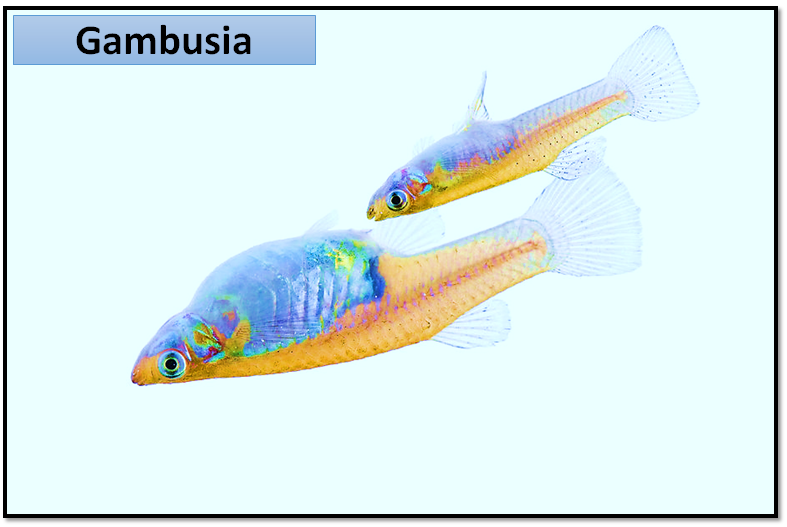
A larvivorous fish is
(a) Gambusia
(b) Solea
(c) Anabas
(d) Diodon
Answer
492.3k+ views
1 likes
Hint: Western mosquitofish are freshwater fish species, often generally known, if ambiguously, as mere mosquitofish or by their generic name. Since the fish consumes mosquito larvae, the name 'mosquitofish' was given and has been used more than any other fish for the biological control of mosquitoes.
Complete step by step answer:
Gambusia is a large genus in the Poeciliidae family (order Cyprinodontiformes) of viviparous fish. There are over 40 species in Gambusia, most of which are found mainly in freshwater environments, although some species may be found in brackish or saltwater environments as well. Cuban Gambusia is the type species.

Gambusia is a large genus of freshwater fish, although there are several species found in saltwater or brackish environments. Gambusia affinis and Gambusia holbrooki are two species. They will feed on the larvae of mosquitoes and, thus, are called mosquitofish.
They are only rarely kept in aquariums due to their relative lack of color.
Additional information: The common sole, the Dover sole, or the black sole, is a flatfish species in the Soleidae family. It lives on the sandy or muddy seabed of the North Atlantic and the Mediterranean Sea, where it is mostly semi-submersible. The upper side is greyish-brown, while the lower side is white. Anabas is a genus of climbing gourmands native to southern and eastern Asia. In the wild, the species of Anabas grow up to 30 cm in length. They live in both brackish and freshwater. Fish of the genus Diodon have two-root, movable spines (derived from modified scales) distributed over their bodies. Beak-like jaws used to crush their hard-shelled prey (crustaceans and mollusks) .
So, the correct answer is ‘Gambusia’.
Note: Mosquitofish (Gambusia holbrooki) is an edible tropical fish considered to be one of the most dangerous invasive species on a global scale, according to the International Union for the Conservation of Nature (IUCN).
Complete step by step answer:
Gambusia is a large genus in the Poeciliidae family (order Cyprinodontiformes) of viviparous fish. There are over 40 species in Gambusia, most of which are found mainly in freshwater environments, although some species may be found in brackish or saltwater environments as well. Cuban Gambusia is the type species.

Gambusia is a large genus of freshwater fish, although there are several species found in saltwater or brackish environments. Gambusia affinis and Gambusia holbrooki are two species. They will feed on the larvae of mosquitoes and, thus, are called mosquitofish.
They are only rarely kept in aquariums due to their relative lack of color.
Additional information: The common sole, the Dover sole, or the black sole, is a flatfish species in the Soleidae family. It lives on the sandy or muddy seabed of the North Atlantic and the Mediterranean Sea, where it is mostly semi-submersible. The upper side is greyish-brown, while the lower side is white. Anabas is a genus of climbing gourmands native to southern and eastern Asia. In the wild, the species of Anabas grow up to 30 cm in length. They live in both brackish and freshwater. Fish of the genus Diodon have two-root, movable spines (derived from modified scales) distributed over their bodies. Beak-like jaws used to crush their hard-shelled prey (crustaceans and mollusks) .
So, the correct answer is ‘Gambusia’.
Note: Mosquitofish (Gambusia holbrooki) is an edible tropical fish considered to be one of the most dangerous invasive species on a global scale, according to the International Union for the Conservation of Nature (IUCN).
Recently Updated Pages
Master Class 10 Science: Engaging Questions & Answers for Success

Master Class 10 Social Science: Engaging Questions & Answers for Success

Master Class 10 Maths: Engaging Questions & Answers for Success

Master Class 10 English: Engaging Questions & Answers for Success

Class 10 Question and Answer - Your Ultimate Solutions Guide

Master Class 9 General Knowledge: Engaging Questions & Answers for Success

Trending doubts
State and prove Bernoullis theorem class 11 physics CBSE

1 ton equals to A 100 kg B 1000 kg C 10 kg D 10000 class 11 physics CBSE

State the laws of reflection of light

One Metric ton is equal to kg A 10000 B 1000 C 100 class 11 physics CBSE

Difference Between Prokaryotic Cells and Eukaryotic Cells

1 Quintal is equal to a 110 kg b 10 kg c 100kg d 1000 class 11 physics CBSE




